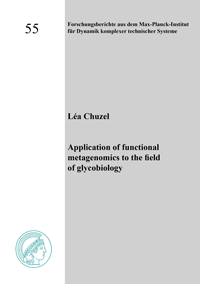
Shop : Details
Shop
Details
49,80 €ISBN 978-3-8440-8437-5Softcover246 pages66 figures365 g21 x 14,8 cmEnglishThesis
February 2022
Léa Chuzel
Application of functional metagenomics to the field of glycobiology
Bacteria account for ~15% of the earth’s biomass and are the second largest biomass contributor after plants. Bacteria are ubiquitous and have adapted to live in all habitable ecosystems on our planet resulting in a vast diversity estimated to be 1 trillion different species. The genomes of these microbes represent an extraordinary resource for novel enzyme discovery. The field of metagenomics strives to access these genomes, in particular, those from uncultivable species that have been otherwise out of reach.
Glycobiology is a field of research that addresses the structure, function, and biology of glycans and glycoconjugates. Glycans have wide-ranging importance in both basic biology and pharmaceutical science. In this thesis work a functional metagenomic workflow that relies upon large-insert metagenomic libraries created in Escherichia coli was established. A collection of almost 100,000 clones was created from diverse ecosystems including extreme environments, and is estimated to contain 3-4 million of environmental genes. Three activity-based screens were executed using libraries in this collection. The first led to identification of a novel exosialidase having a unique catalytic mechanism and new protein structure that defined a new glycoside hydrolase family (GH156). The second screen isolated two sialidases with a preference for a non-human form of sialic acid. Finally, a third screen identified two enzymatic activities: a sugar-specific sulfatase and a sulfate-dependent hexosaminidase that can act on sulfated glycans, an important chemical modification of N-glycans for which well-defined analytical tools have yet to be established.
Glycobiology is a field of research that addresses the structure, function, and biology of glycans and glycoconjugates. Glycans have wide-ranging importance in both basic biology and pharmaceutical science. In this thesis work a functional metagenomic workflow that relies upon large-insert metagenomic libraries created in Escherichia coli was established. A collection of almost 100,000 clones was created from diverse ecosystems including extreme environments, and is estimated to contain 3-4 million of environmental genes. Three activity-based screens were executed using libraries in this collection. The first led to identification of a novel exosialidase having a unique catalytic mechanism and new protein structure that defined a new glycoside hydrolase family (GH156). The second screen isolated two sialidases with a preference for a non-human form of sialic acid. Finally, a third screen identified two enzymatic activities: a sugar-specific sulfatase and a sulfate-dependent hexosaminidase that can act on sulfated glycans, an important chemical modification of N-glycans for which well-defined analytical tools have yet to be established.
Keywords: functional metagenomics; glycobiology; sialidase; sulfatase; glycoside hydrolase; enzyme discovery; screening
Forschungsberichte aus dem Max-Planck-Institut für Dynamik komplexer technischer Systeme
Edited by Prof. Dr. Peter Benner, Prof. Dr.-Ing. Udo Reichl, Prof. Dr.-Ing. Andreas Seidel-Morgenstern and Prof. Dr.-Ing. Kai Sundmacher, Magdeburg
Volume 55
Available online documents for this title
DOI 10.2370/9783844084375
You need Adobe Reader, to view these files. Here you will find a little help and information for downloading the PDF files.
Please note that the online documents cannot be printed or edited.
Please also see further information at: Help and Information.
Please also see further information at: Help and Information.
| Document |  | Document | ||
| Type |  | |||
| Costs |  | 37,35 € | ||
| Action |  | Purchase in obligation and download the file | ||
| Document |  | Table of contents | ||
| Type |  | |||
| Costs |  | free | ||
| Action |  | Download the file | ||
User settings for registered online customers (online documents)
You can change your address details here and access documents you have already ordered.
User
Not logged in
Export of bibliographic data
Shaker Verlag GmbH
Am Langen Graben 15a
52353 Düren
Germany
Am Langen Graben 15a
52353 Düren
Germany
Mon. - Thurs. 8:00 a.m. to 4:00 p.m.
Fri. 8:00 a.m. to 3:00 p.m.
Fri. 8:00 a.m. to 3:00 p.m.
Contact us. We will be happy to help you.



